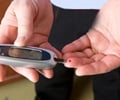Researchers from University of Warwick have discovered certain key markers that may help identify a far greater number of people who are at a high risk of developing type 2 diabetes in future.
Researchers from University of Warwick have discovered certain key markers that may help identify a far greater number of people who are at a high risk of developing type 2 diabetes in future.
The team have found markers that indicate endothelial dysfunction changes in the cells, which line the blood vessels and sub-clinical systemic inflammation, the factors responsible for Type 2 diabetes.Lead researcher Dr Saverio Stranges, Associate Professor of Cardiovascular Epidemiology at Warwick Medical School at the University of Warwick along with his colleagues focused their study on protein called E-selectin.
The presence of this protein indicates endothelial dysfunction, white blood cell count and levels of albumin, which are marker for sub-clinical systemic inflammation.
The study revealed that high levels of E-selectin and white blood cell count with low levels of serum albumin were clear predictors of high risk for type 2 diabetes.
Researchers also found that traditional risk factors such as obesity or family history helped identify 65pct of all patients who were at high risk of developing type 2diabetes.
But when these three markers were added this increased from 65 pct to 73 pct.
Advertisement
"These findings corroborate the notion that both these conditions play an important role in the development of the disease. Endothelial dysfunction is also regarded as a key event in the development and progression of atherosclerosis.
Advertisement
Source-ANI
SRM/M











